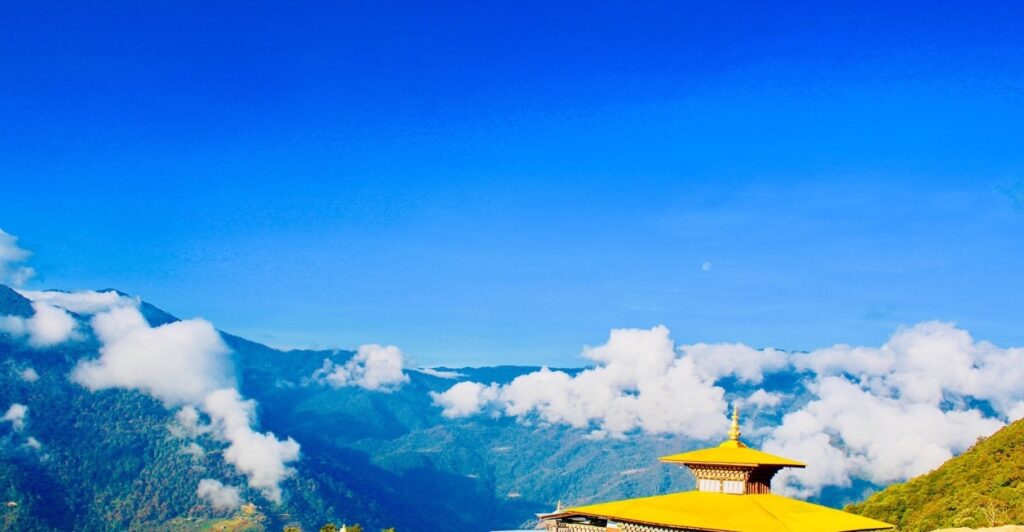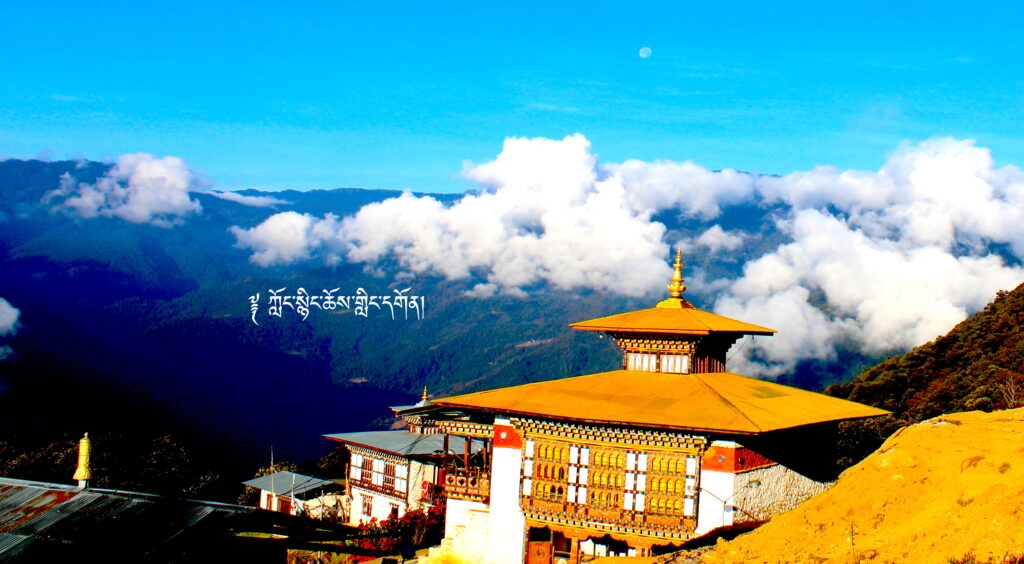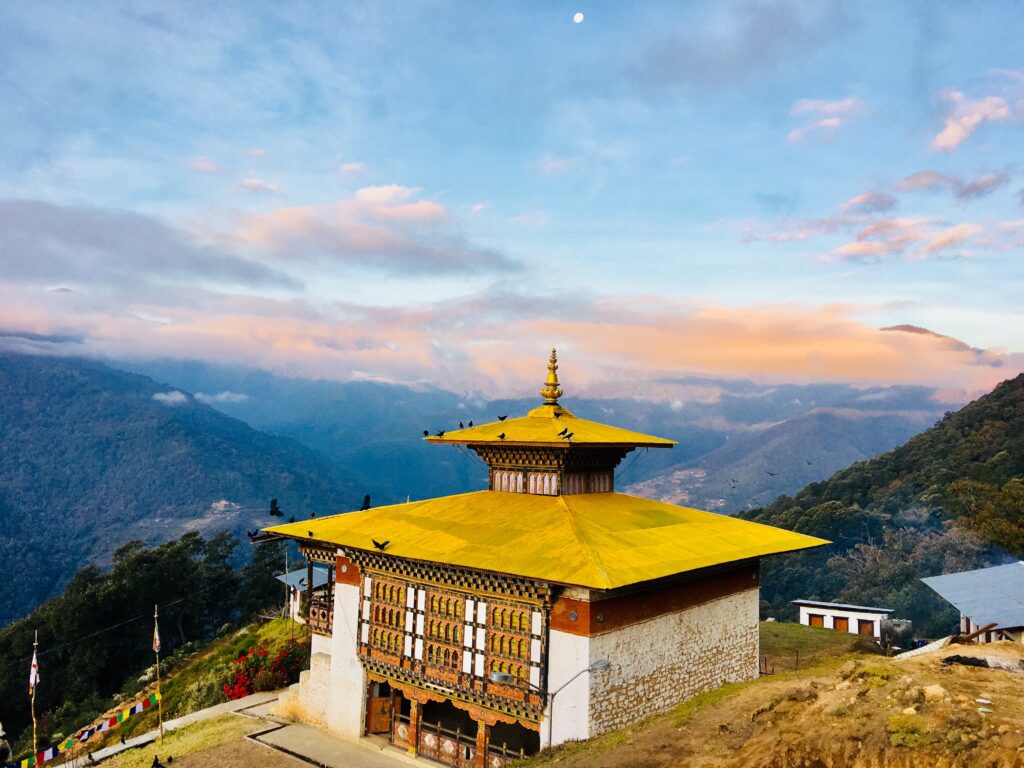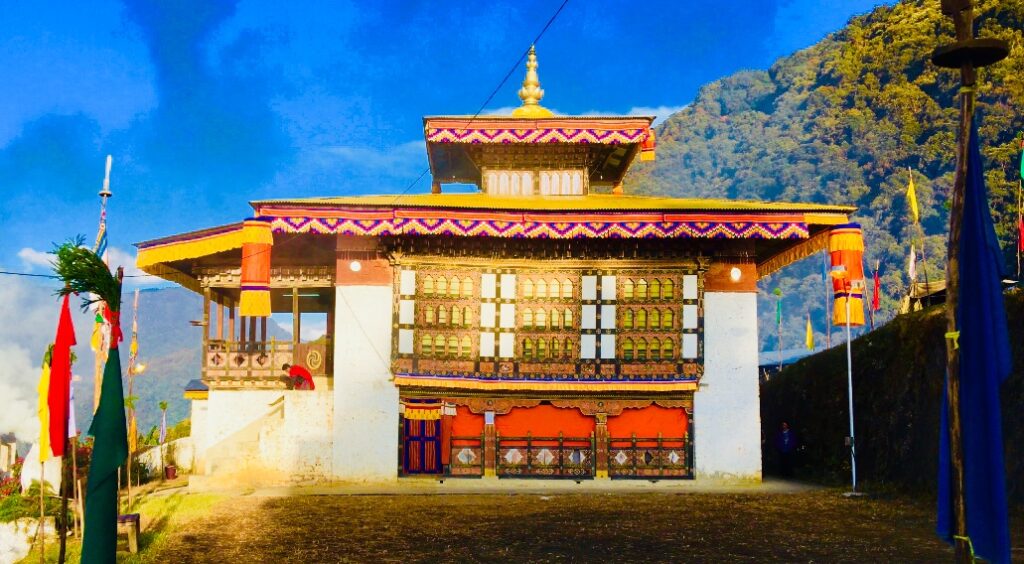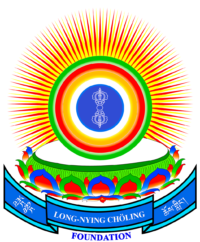A Concise Historical Overview of Long-nying Chöling Monastery
Long-nying Chöling Monastery is nestled above the historical village of Longkhar Chakidemig, on Blongla Mountain, which resembles a yogi seated in a lotus posture. Located in Khamdhang Gewog (block) in the Trashiyangtse District of Eastern Bhutan, this region, known as the land of medicinal herbs and the pure land of Sacred Dharma, exemplifies the essence of Bhutan.
This place is considered part of the sacred site blessed by Guru Rinpoche, as stated in an ancient guidebook (Tib: Neyig) and evidenced by texts petitioning the local deity Blogong Lhatsen, who dwells in Blogongla Mountain and was bound under the oath by Guru Rinpoche. Additionally, the area is surrounded by many well-known sacred sites, such as Ombha (the Tiger’s Nest of Eastern Bhutan), Gomphukora, and Gongja, which are considered the lower parts of the sacred site of Pema Ling, the king of sacred sites in Eastern Bhutan.
As mentioned in the Crystal Cave Chronicle of Guru Rinpoche (known as Kathang Sheldrakma), revealed by the treasure revealer Orgyan Lingpa (1323–c. 1360), there are five regions, one abode or sanctuary, and twenty-one sacred mountain ranges identified as Guru Rinpoche’s hidden lands. Pema Ling is recognized as one of these sanctuaries. Furthermore, marvelous rock cliffs with various marks of Guru Rinpoche’s miracles are still visible at the sacred site called Tsangphuchen, just behind the monastery’s mountain. Blongla Mountain is adjacent to the sacred site of Ombha.
Just a mile above the monastery and to the south lie massive ruins, now covered by ground and thick forest, believed to be from a monastery or fortress dating back to the time of Tibetan Prince Tsangma in the 9th century. This location has been a sacred retreat for Dharma practitioners due to its secure location and natural amenities, such as drinking water, panoramic views, and green forests with abundant wild vegetables and fruits.
Another indication of the sacredness of this land is the presence of several sacred sites of Masang along the trail from Longkhar Village to the north. Masangs, generally considered proto-historical humanoids, are believed here to be born from a human mother and a spirit father, incarnations of Guru Rinpoche or enlightened beings, aiding in helping beings and challenging negative spirits.
The present Long-nying Chöling Monastery was established by a Longchen Nyingtik Yogi named Pema Drakpa in 1906, during the Fire Horse year of the 15th Rabjung Cycle, following a prophecy. Born in Zhokpadung, Kurtö, in the Lhuntse District, Yogi Lama Pema Drakpa sought greater spiritual advancement as he grew up and traveled to Tibet. There, he studied extensively under renowned Nyingma Masters such as Jamyang Kyentse Wangpo and other distinguished Dzogchen Masters. Upon returning to Bhutan, he practiced as a wandering yogi, moving indefinitely from place to place.
During his travels, he was hosted by Chokdar, a local landlord, and his wife, Rinchen Lhamo, in their village. They requested him to establish a monastery and serve as the head Lama to benefit the local people. Recognizing the fulfillment of Guru’s prophecy and the opportunity to benefit the community, the yogi accepted. The two-story Long-nying Chöling Monastery wassuccessfully built, featuring human-sized statues of Shakyamuni, Guru Rinpoche, Amitabha, Amitayus, Avaloketeshvara, Vasudhara, and White Tara, created with the support of the local community as objects of veneration and sources of merit accumulation.
During the consecration ceremony, many auspicious signs manifested. The monastery was named Long-nying Chöling, meaning “the abode of Longchen Nyingtik (Heart Essence of the Vast Expanse),” a Nyingma cycle of teachings and practices discovered by the omniscient Jikmé Lingpa as a mind treasure. Furthermore, Pema Drakpa assigned Gyalpo (King) Pehar as the Dharmapala (protector of the doctrine) of the temple, mirroring Guru Rinpoche’s actions after establishing Samye Monastery in Tibet. Under Pema Drakpa’s direction, a twelve-volume set of the Prajnaparamita Sutra from Lhasa was imported and enshrined in the temple as a support of Enlightened speech, and a stupa of enlightened activity was built by the roadside at the lower part of the village as a support of enlightened mind in the region. Despite his profound influence and deep connection to the local people, Pema Drakpa chose a secluded hermit lifestyle, passing away like a wandering yogi without public knowledge, following the tradition of past yogis.
Subsequently, numerous enlightened masters have resided in and consecrated this monastery. The monastery preserves many sacred relics and supports of enlightened body, speech, and mind, bringing blessings to the entire surrounding community.
The second abbot of this monastery was Yogi Lama Phuntsog Dorje (1902-1985), son of Zimgarpa Chagdor, a resident of Zhal-ngo Nagtsang. He was a steward and relative to the first King of Bhutan in Kurtoe Dungkhar, Lhuntse. Lama Phuntsog Dorje entered the Dharma at a young age and became the chief disciple of Yogi Lama Choying Rangdrol, a renowned Dzogchen Master from Tibet. Lama Choying Rangdrol taught Dzogchen in the valleys of Trashiyangtse and Kurtoe. Lama Phuntsog Dorje traveled to Tibet with his Guru and then returned to Bhutan to practice as a wandering yogi, maintaining a low profile as advised by his root guru. During a pilgrimage, he met his consort, a noblewoman from Longkhar and paternal aunt of the fourth abbot, Lama Sonam Wangdi. They married, and Lama Phuntsog Dorje was invited to be the Lama of Long-nying Chöling Monastery. He spent most of his time in strict retreat atop Blongla mountain, above the monastery.
During his retreat, Dharma practitioners, including the fourth abbot Lama and his son, the fifth abbot Lama Norbu Wangdi, were drawn to him. They practiced nearby in bamboo huts. Later, he descended near the monastery, where disciples again gathered around him and engaged in retreats.
While Lama Phuntsog Dorje was on Blongla mountain for almost four years, the monastery’s abbot responsibilities were temporarily assumed by Drupthop Jangchub Palzang, an incarnated Lama renowned for his clairvoyance and miracles in Trashiyangtse valley and Tawang district of Arunachal Pradesh, India. He lived as a Mahasiddha, taking Lama Sonam Wangdi’s sister as a consort and benefiting the people of the region until he left for Tawang. During his time, he discovered new holy spring waters at the monastery, which subsequently became a drinking water source for the community. After Lama Phuntsog Dorje left for further seclusion, Ven. Lama Sonam Wangdi (1914-1990) became the fourth abbot. His ancestors belonged to the Treasure Revealer Guru Chöwang’s clan in Kurtoe. Following him, Ven. Lama Norbu Wangdi (1945-), his eldest son, became the fifth abbot. Detailed information about his life can be found in his extensive biography, which describes how he studied under more than 50 masters, including His Holiness Dudjom Jigdral Yeshe Dorje, the recent regent of Guru Padmasambhava. He undertook the massive challenge of completely renovating the century-old Long-nying Chöling Monastery, acquiring statues, commissioning mural paintings, and procuring sacred texts such as the Kangyur (Translation of the Buddha’s Canon) and Tengyur (Translation of Treatises). He also instituted Drupchens, Drupchods, the annual Tsechu festival, and other ceremonies since 1987. Ven. Lama Norbu Wangdi’s only son, Lama Dolma Wangdi, received rigorous Dharma training from childhood under his father and other masters, including the Great Yogi Lama Sonam Druktop. He assisted with monastic management for a few years but passed away suddenly after completing a three-year retreat.
At present, Ven. Lama Norbu Wangdi is fully supported and assisted by his grandson, Ven. Khenpo Namchak Dorji, who is the only son of the late Lama Dolma Wangdi and is considered to be the rebirth of the second abbot, Ven. Lama Phuntsog Dorje. His detailed biography can be found here (link). He is the main successor of Ven. Lama Norbu Wangdi and the founder and vice chairman of the Long-nying Chöling Foundation, which is registered under the Commission for the Religious Organization of Bhutan. Given Lama Norbu Wangdi’s advanced age, Ven. Khenpo Namchak Dorji now shoulders full responsibility for constructing a three-year retreat center, a monk school, and overseeing major construction projects and events at the monastery.
